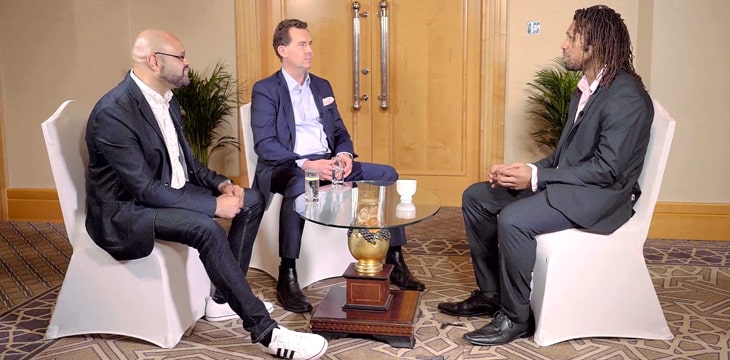|
Getting your Trinity Audio player ready...
|
https://www.youtube.com/watch?v=kvbC7qI6WEU
In this episode of More Than Money, CoinGeek’s Patrick Thompson talks to Ketan Makwana and Michael Jacobsen about the various ways blockchain technology and digital assets can bring value to creative media. It’s clear that there are still many obstacles to be overcome but that the value the metaverse unlocks will be explosive.
Who are Ketan Makwana and Michael Jacobsen?
Makwana is chairman and co-founder of Seventy7 Ventures, a venture platform focusing on raising capital and spinning off projects, particularly in the creative industry. Jacobsen is his co-founder and CEO, with a background in the entertainment business. He knows the strengths and weaknesses of each sector inside out.
How do you see creatives getting involved in blockchain and digital assets?
Makwana says creatives are artists and artisans, and as such, they don’t necessarily understand what blockchain technology or the metaverse is or can mean to them. Seventy7 Ventures wants to bring in resources and educational materials to help them know more. It intends to accelerate the entrance of artists into this industry.
Thompson sees a lot of artists interested in NFTs and the metaverse. He asks whether Seventy7 Ventures experiences the same and asks them to define the metaverse.
Jacobsen answers that the metaverse is “many different things to different people.” He describes it as a virtual world that will, in some ways, replicate the physical world. He sees a lot of genuine ignorance on behalf of everyone and likens it to the early days of the internet. He says Seventy7 works with artists to help them commercialize their work using the metaverse. “If you can’t commercialize, you can’t eat, and if you can’t eat, you can’t create,” he says.
Makwana says that the metaverse is borderless, and he sees lots of opportunities there. He believes it will open many new opportunities, such as allowing a single mother in the Philippines to have a job when she’s not looking after her child. He believes it extends the way we live, engage, and communicate, and it will change how we live our lives going forward.
However, Makwana also points out that an estimated 60% of Americans fear the metaverse. He puts that down to a lack of proper education about what it is. He believes that the best way to change this is to build bridges, showing people what it is by introducing them to positive metaverse experiences. He gives the example of allowing people to attend a basketball match in a metaverse version of Madison Square Gardens.
What are some of the obstacles in the way of this vision coming to fruition?
Thompson says he loves the idea of attending a basketball match in the metaverse. However, he also points out that, right now, many people get motion sickness when using VR headsets to enter virtual worlds. He asks the pair for their views on some of the obstacles to making the grand vision of the metaverse a reality.
Jacobsen acknowledges the “human obstacles” Thompson mentioned, but he also says that another is that most businesses have to operate in the now. He points out that most are trying to survive and aren’t necessarily able to plan and invest for outcomes 10, 20, or 30 years down the track.
Makwana says that, right now, there’s not enough going on to warrant lots more development of things like VR headgear. While we have products like Oculus, they’re still quite expensive. However, like the age of TV, he believes we’ll see a rapid evolution of hardware, driving costs down. He expects a price range of $350-$380 to be the point at which it becomes a home product, but this will only happen when there’s plenty of software to incentivize the manufacture of this hardware.
What will it be that draws people into metaverses, and what can creatives do to catalyze that shift?
Makwana says we should look to millennials and generation z. They were born with smart devices and understood the digital world much more intuitively. He believes providing them with more opportunities is the key, and the rest will take care of itself.
As for older generations, he believes they require more encouragement, and that’s where building the bridges between the physical and digital worlds comes back in; helping them into the metaverse is the key, and from there, they can be introduced to the larger virtual world.
How can creatives make money in the metaverse?
Makwana expresses frustration at how everyone sees the metaverse as an opportunity to advertise. “Right now, it’s just billboards and banners,” he says. He encourages them to look beyond this and to see the opportunities, such as the one he outlined earlier about letting people from all over the world work remotely.
“Monetization isn’t just around ad spend and creating a new product,” he says, pointing out that the metaverse will create a new economy for consultation fees, development, and much more. He says that when businesses realize this and move away from billboards and banners, the opportunities for monetization are going to explode.
Jacobsen points out that while individual creatives don’t have the budgets of big companies, they also don’t have the same short-sightedness and constraints. “They don’t have to worry about the next quarterly results,” he says. He believes that lots of creative minds will sow seeds into the concept of the metaverse with a long-term view rather than in an attempt to make a quick buck.
What are they most optimistic about regarding this space?
Makwana answers that the most exciting part is democratizing talent and how it is rewarded. He is also excited that we get a second chance to redo the internet with all the lessons learned from the first iteration. “Web 3.0 is our chance to go back and do it again,” he says.
Jacobsen is excited about the chance to reimagine the future in a better and more enhanced way using these new technologies (BSV blockchain in particular.) He’s particularly interested in the opportunities to educate people about what this technology can do and, in so doing, bring more talent and brainpower into the space.
Thompson circles back to the point about some people being afraid of the metaverse. He asks how people can better prepare and educate themselves so they have the tools, resources, and skills needed for this future.
Makwana answers that Seventy7’s educational platform, Cryptolitics, is there for anyone who wants to learn. It provides news, an academy with learning materials and resources, and it will offer live streamed events from around the world in the not-too-distant future.
General takeaways from the Seventy7 Ventures partners
Thompson always wraps up his interviews by asking the guests for some general takeaways for the audience. He asks Makwana and Jacobsen for theirs.
Jacobsen says that he wants to emphasize the importance of creativity. He points out that creativity exists everywhere, from fine artists painting to people within governments and companies who want to embrace the future. He wants creatives to realize the opportunities that lie ahead.
Makwana says his simple takeaway is that it’s all about value exchange. He urges people to come into it with an idea of what they can create that’s of value. He encourages us not to just focus on the money in the space—the money will come when we share value.
Key takeaways from this More Than Money conversation
Every More Than Money conversation ends with a roundup of the key takeaways. Here’s what we learned in this one.
- Blockchain technology increases a creator’s opportunity to earn and connect with their audiences.
- The metaverse is most valuable when it creates opportunities by removing geographical borders.
- End-users need to understand why blockchain can improve their lives.
Watch: The BSV Global Blockchain Convention panel, Metaverse, NFTs & Blockchain
https://www.youtube.com/watch?v=pf2LcdDLerQ

 01-05-2026
01-05-2026 




